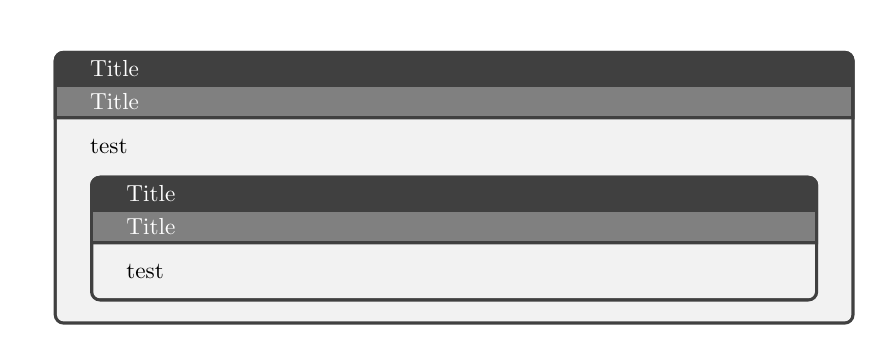samcarter

I'm trying to create a tcolorbox which sets the title depending on a boolean `\iftitle` and leaves it empty otherwise.
My current workaround is to set it outside the tcolorbox via `\tcbsetforeverylayer` (using this instead of `\tcbset` to make sure it also works in nested boxes). However this has the unintended side effect that the title will be shown twice for boxes with the `attach boxed title to top` option.
As a workaround, I could force a reset of the title's title with `boxed title style={title={}}`, but I was wondering if there is another way to set the title only conditionally?
```
\documentclass{article}
\usepackage[most]{tcolorbox}
\newif\iftitle
\titletrue
\newenvironment{foo}{
\iftitle
\tcbsetforeverylayer{title={Title}}
\fi
\begin{tcolorbox}[
enhanced,
attach boxed title to top,
% boxed title style={title={}}
]
}{\end{tcolorbox}}
\begin{document}
\begin{foo}
test
\begin{foo}
test
\end{foo}
\end{foo}
\end{document}
```

Top Answer
samcarter

So, rubber duck debugging worked great!
Just after posting this question, I had the idea to check how `IfValue` etc. are defined in tcolorbox:
```
IfValueTF/.code~n~args={3}{\tl_if_novalue:nTF{#1}{\pgfkeysalso{#3}}{\pgfkeysalso{#2}}}
```
With a bit of modification, one can do something like this:
```
\documentclass{article}
\usepackage[most]{tcolorbox}
\newif\iftitle
\tcbset{
if/.code n args={3}{
#1
\pgfkeysalso{#2}
\else
\pgfkeysalso{#3}
\fi
},
}
\newenvironment{foo}{
\begin{tcolorbox}[
enhanced,
attach boxed title to top,
if={\iftitle}{title={ttt}}{}
]
}{\end{tcolorbox}}
\begin{document}
\begin{foo}
test
\begin{foo}
test
\end{foo}
\end{foo}
\titletrue
\begin{foo}
test
\begin{foo}
test
\end{foo}
\end{foo}
\end{document}
```
Answer #2
Skillmon

Though there is nothing inherently wrong with the [nice answer by samcarter](https://topanswers.xyz/tex?q=2097#a2349), the following builds upon it to increase its robustness (since TeX's rules for nesting `\if`s can lead to surprises, and so having an unbalanced `\if` in some code or nesting `\if`s can lead to breakage).
For this reason this answer slightly alters the syntax to only get the conditionals name and build the real control sequence using `\csname`, while also not using the `\pgfkeysalso` code inside the `\if`-structure but using LaTeX2e-style branching.
```
\makeatletter
\providecommand\@secondofthree[3]{#2}
\tcbset
{
if/.code n args = {3}{%
\csname #1\endcsname\expandafter\@secondofthree\fi
\@secondoftwo{\pgfkeysalso{#2}}{\pgfkeysalso{#3}}}
}
\makeatother
```